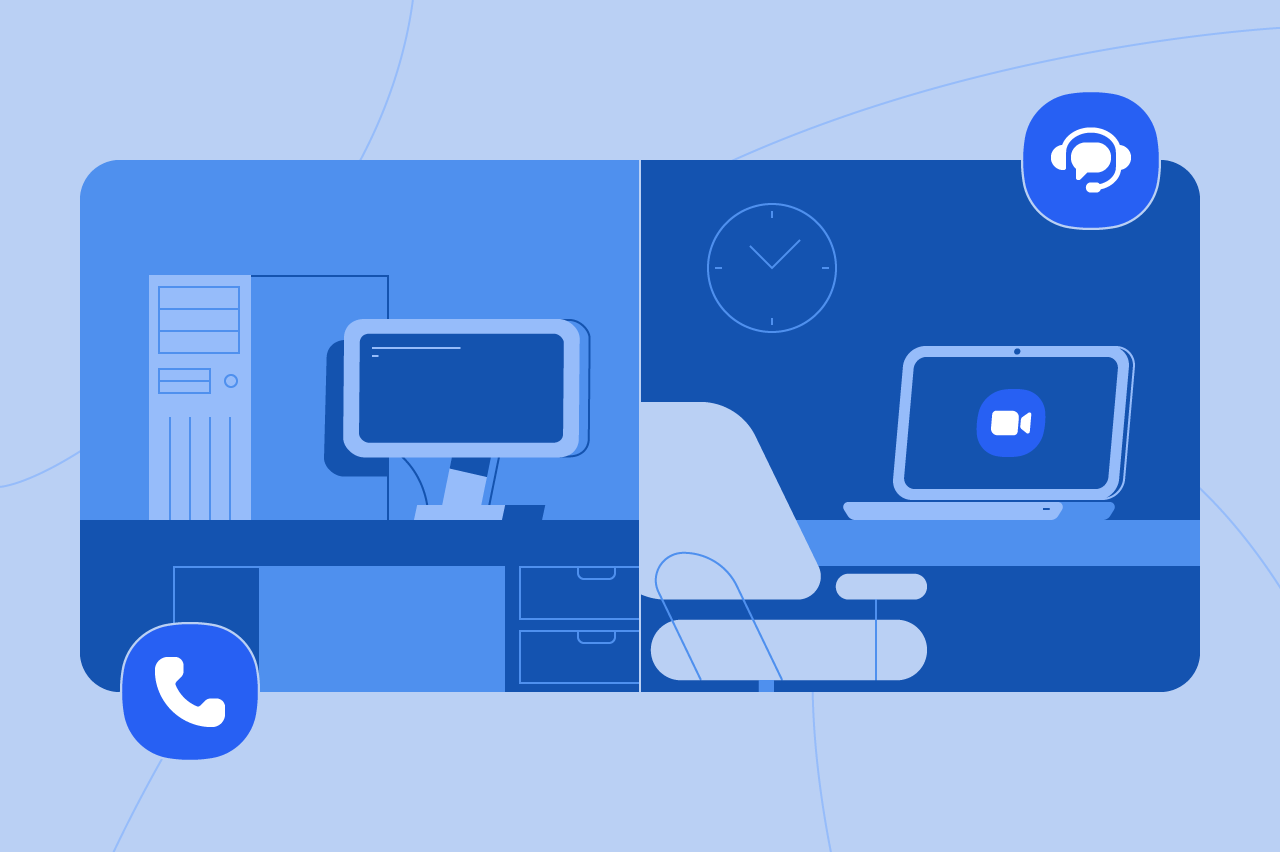
What is a cloud contact center and how to choose the best one
Explore what a cloud contact center is and how it's different from traditional contact center solutions. Explore features and tips to choose the right software.
Updated on January 30, 2025
Published on October 12, 2023


If you run a restaurant, you can generally tell who your unhappy customers are. They’ll be the ones scowling at their overcooked food or glaring at their phones while waiting too long for a dish. If your servers pay close attention, ask for feedback often, and work to make problems right, they should be able to turn negative experiences into positive ones. They can also avoid frustrated diners turning to Yelp to write one-star reviews or blasting your brand on social media with posts filled with customer complaints.
Unfortunately, when you manage an online business, you don’t have as much visibility into how your customers are feeling about your company. However, bad experiences can have an equally — or greater — impact on your bottom line. The quality of an online business’s customer service can make all the difference.
So, what are the most common complaints regarding customer service? Here’s what you need to know about keeping your customers happy, meeting their expectations, and building a growing base of satisfied customers.

Although meeting customer expectations is important for any brand, it’s a particularly important part of the job for customer service reps at an online company. Customer calls may be the only person-to-person interactions the company has with its customers. Therefore, it’s critical to have a team skilled enough to deliver excellent customer experiences and expertly address customer complaint resolution. An issue managed to the customer’s satisfaction can make the difference between customer retention and churn. Every customer relationship salvaged means continued revenues and growing customer lifetime value (CLTV), metrics that are vital to your business’s financial position.
To maintain a healthy customer retention rate, it’s important to know what the most common complaints regarding customer service are and how to make sure your company does all it can to avoid them.
While there are plenty of things an angry customer might take issue with — maybe you sent her the wrong sized dress, or her order hasn’t arrived within three days as promised — the data shows that what really puts customers off isn’t the problem itself; it’s how your company handles interactions with dissatisfied customers.
Here’s a look at some of the most common customer complaints that make a customer unlikely to do business with a company in the future and how you can manage these common problems to build better customer experiences.
When you ask customers what their most common complaint regarding customer service is, one of the first answers you’ll get is that it takes too long to get the answers they need. Several factors stand in the way of easy access to information, including customer service teams that:
Keep customers on hold for too long
Connecting with a caller before you’ve reached the limit of their patience is one of the basics of customer service. A recent Zoom study found that 52% of consumers report long wait times as what contributes to a negative support experience.
Know what’s acceptable to your customer base and make sure wait times line up with it.
Also, wait times for chat support can vary, with averages ranging from nearly instant responses to about a minute and a half. Times on the higher end of the spectrum may lead to frustration for customers looking for a quick way to engage for help or information.
Are slow to respond to emails
Although business etiquette dictates responding to emails within 24 hours, customers reaching out for support will want answers much more quickly. A 2020 survey found that one-third of customers expect a reply in one hour or less. Ensure you have the resources to respond to emails in a timely manner.
Are unresponsive on social media
Sprout Social reports that more people are using social media to contact support. Among them, 22% percent expected a response in 2-12 hours, 22% expected a response in 1-2 hours, and 13% in less than one hour. Ensure members of your staff are monitoring social media and responding quickly to customer service requests.
If you suspect your team is falling short of expectations for response and issue resolution times, use data analytics to track your team’s performance. Even if your customers aren’t actively complaining, you may see churn if response times are higher than what your customers consider reasonable.
Also, look for ways to streamline your intake process and reduce ticket volume by routing customers to a self-service platform to address easy-to-answer questions so that only customers who need genuine help will be routed to phone or chat support.
Of course, you’ll also want to keep an eye on your staffing ratios compared to your customer base. If your audience is growing quickly, you’ll likely need to increase your customer support team in turn, but using self-service can help to reduce ticket volume even as your audience grows.
When customers call your service team, they expect fast, effective resolutions to their problems. But, another common complaint regarding customer service is that it’s difficult to find someone who can resolve their issues due to:
Misinformation
An Accenture survey found that one of the most common complaints regarding customer service, cited by about 50% of customers, is having to explain issues again and again. No one wants to call customer service repeatedly because they didn’t get the right answer the first time. They expect to reach customer service agents who understand the products they use and how they work and accurately provide information on them.
Inability to answer questions
If a customer has had to wait to speak to a rep and has an issue that requires help to resolve, the last thing you want your customer service team to do is stammer through an apology that they don’t have a solution. Customer service reps need instant access to information and assistance so they can meet customer expectations for expediency.
Staff confusion
When customers reach out for support, they become flustered if they reach a call center agent who can only provide scripted responses that don’t resolve their problem. They’re also frustrated if they’ve previously talked to another customer support agent, their new rep doesn’t have the context of the situation, and they need to start from scratch. Make sure that your customer support tools can gather the context of your customer’s problem in advance so you know exactly where to route him for help.
One way to solve the problem of how to connect customers with accurate information quickly is to implement a self-service solution that they can use to search for relevant content in your company’s knowledge base. Also, give customers a way to connect with a rep in the right department if they can’t find the answers they need on their own.
Getting stuck in phone menu limbo was a serious issue for customers. Make sure the customer experiences your service team provides don’t include a loop that customers can’t escape due to a:
Customers can quickly become frustrated if they can’t access the right department with the choices offered on the interactive voice response (IVR) system or have no option to talk to a live customer support agent. A survey conducted by CSG found that 36% of respondents would rather wait on hold to speak with a human agent than use an AI-powered virtual assistant to resolve their issue.
Consider doing away with phone menus. If customers visit your website and look for support options, provide a self-service portal where they can find the answers to their questions independently. In the event that they can’t, your solution should route them directly to a specialist in customer support who has the subject-matter expertise to answer their questions.
Customers are put off by terse communications or failure to understand or respond fully to questions. There are several reasons this can occur:
Agent burnout or disinterest will likely come through when they speak with customers. Keep a close watch on your company’s environment and culture to ensure employees are satisfied with their work and engaged.
Make sure that each of your agents is well-trained in how to listen to customers with empathy, apologize when needed, and take accountability for problems that have occurred. Train your customer support team on recognizing the various types of difficult customers they may come across and how to respond according to each one’s communication style. Taking the time to actively listen to their complaints, clarify your company’s position, and create a plan to resolve the issue can go a long way towards smoothing over a situation.
Customer service reps may have biases they aren’t aware of. For example, they may have preconceived notions when they hear an accent, see how a customer’s name is spelled, or see their address. Train your team to put those ideas aside and treat everyone with the same respect and concern.
Your customer service team is the face of your company and your brand. Make sure they represent you appropriately.
Customers’ objectives when they call your customer service team are to resolve their issues. Unfortunately, some of your customer service team’s bad habits can prolong resolutions, including:
Agents who are more concerned with moving people through the queue rather than solving problems can lead to bigger problems. It’s smarter to take the time to understand the problem, identify next steps, and overcome them so the customer won’t have to call again.
Agents may fall back on sending issues up the chain too often, causing bottlenecks and delaying resolutions. Give your team the training, tools, and confidence they need to address the problems on their own.
Occasionally, resolutions are stalled because agents don’t listen to customers or what they really want. Encourage your team to listen actively so they can identify exactly what will lead to customer satisfaction.
Deploying self-service options to handle easy customer queries or to complement your customer service resources is a great strategy. However, it can backfire if you don’t avoid these pitfalls.
Creating and launching a knowledge base or other self-service tool won’t decrease the number of calls or tickets your team has to address if it doesn’t include the information customers are looking for. Use data and customer feedback to determine what customers need and continually update the tool as new issues arise or you add new features or products.
Regardless of how customers would respond to the question, “What is the most common complaint regarding customer service?” the answer will always be tied to communication shortcomings. Some of the factors that can stand in the way of effective communication include:
Depending on your market, you may need to assist customers with different native languages. Multilingual agents can overcome this barrier, but they may be hard to find. Consider using an intelligent, multi-language platform to help fill this gap.
Remind your team that an important part of communication is listening rather than continually speaking. Listening to customers will help them understand the issue at hand and what the customer’s expectation is for a resolution, showing them how to maximize customer satisfaction.
One of the reasons customers call your service team in the first place is because they don’t clearly understand their warranty, service agreement, or company policies. Communicate them effectively at the time of purchase so there’s no question later.

You never want to lose a customer due to an experience with your service or support team. But the repercussions can be much more far-reaching. Even one bad experience can lead to:
Poor customer service has a measurable impact on the bottom line. Qualtrics reports that organizations around the world lost 6.7% of their revenue, approximately $3.11 trillion, when customer satisfaction declined due to negative experiences and consumers took their business elsewhere.
Customers can respond to a bad experience not just by writing a negative review about your business or telling their friends to stay away but by using their purchasing power elsewhere. In fact, a recent Zoom study reported that after a bad customer experience, more than a third of consumers would write a negative online review and 57% would tell a friend or family member to avoid the company. While getting a critical review on a public review site can hurt your business’ reputation, losing customers in droves due to poor service will hurt your bottom line even more.
Unhappy customers can hurt your business, but if you’re able to offer streamlined customer support solutions to help them resolve their complaints quickly, you’ll often be able to impress them with your brand’s customer service so much that you’ll turn them into loyal brand advocates.

If you’ve considered the most common complaints regarding customer service and know you have some work to do to avoid them, consider starting with these:
Proper training can be a significant cost center for companies, particularly when call center employees have a high turnover rate. According to Harvard Business Review, call center turnover can be as high as 45% and double or more than the rate in other positions in a company. But consider what the cost can be in lost business and a negative brand image if you don’t.
Regularly hold service-oriented workshops to prepare your team to provide excellent issue resolution and customer experiences. Focus on training employees on internal processes and company policies. Also, make sure your customer service team has all the technical knowledge they need on your company’s products and instructions on how to optimize customer interactions by providing them with active listening and empathy training.
No matter what the problem is, make sure that you make it easy for customers to resolve the issue through their choice of customer experience solutions — whether that’s self-service, chat support, or phone — and if they want or need to speak with a live agent, make sure that they’re able to reach a customer service team member through streamlined communication channels like an omnichannel contact center to access the expertise to deliver a first-call resolution.
Now that more customers are engaging digitally, you should consider self-service enhancements, such as an intelligent chatbot that responds instantly and manages simple requests so your team can focus on more complex issues. Also, evaluate your help desk or CRM software to ensure it has all of the features your team needs to provide fast, efficient, customer-pleasing service.
Once a call ends, don’t simply assume that the problem is handled. Follow up, either with an automated survey or a phone call, to ensure customer satisfaction and get a better understanding of their experience. You can use a customer satisfaction survey (CSAT) to get a numerical rating of the customer’s satisfaction with various elements of his support experience.
Additionally, consider using the data from your call center or customer relationship management (CRM) solution to analyze complaints and customer queries to learn where your customer service offering needs improvement.
You can also learn more about customers’ sentiments toward your company through external sources. Tools that monitor your online reputation with features for social listening and alerting you to online reviews can also help you keep your finger on the pulse of your customer base.
A customer service role is stressful. It’s impossible to know what to expect with the next call. The customer may be angry or pleasant, have a simple or complex issue, or maybe ask a question the representative has never had to answer before. Agents who take it all in stride and handle each call with confidence and expertise are an asset to your company.
When you find a great customer service employee, it’s important to communicate that to them. Show you trust their skills by empowering them to resolve issues on their own, with the right tools and access to information, of course.
Also, build a culture that clearly demonstrates that you care for your employees and encourages them to be active participants in business success. Consider an employee recognition program that rewards customer service reps for their good work, improving key performance indicators (KPIs), or going above and beyond to resolve customers’ issues.
While it’s impossible to prevent all issues a customer might encounter with your products or services, it is possible to prevent negative experiences — and then reap the benefits.
Wondering how to overcome common complaints regarding customer service at your company? Let us show you how our conversational AI chatbot and cloud contact center can help.